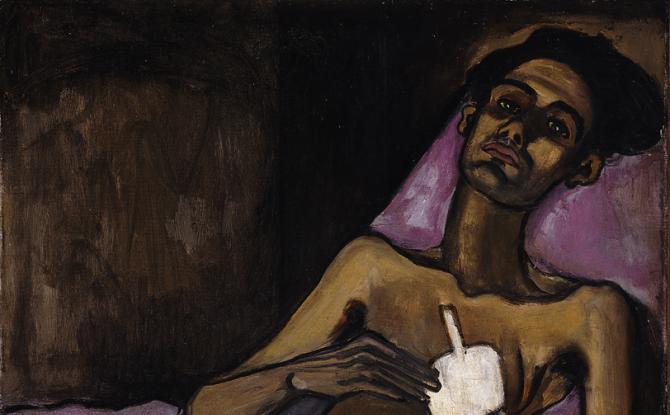Gregory Rutecki
“The personal images in Alice Neel’s work not only reflect her life, they also provide metaphors …There is no peace…in (her) paintings, only agitated recognition of inevitable struggles.”1
“…Alice Neel described the 20th Century as she experienced it, living in the ghetto with those against whom most of society discriminated. She has provided us with a panorama of the poor, the ill, the downtrodden…”2
 |
| Spanish family |
As an artist her oeuvre defies pigeonholing. It has been said, “(her) work was unique… in the way that she could not be tied down into one movement.”3 Her style reflects expressionism and surrealism. Others have recognized her abstract talents.4 Mainstream critics would see a genre expressive of social realism. As an individual however, Alice Neel was even more complicated. In part, she was a feminist. She said, “I didn’t let being a woman hold me back…I never thought it was a man’s world…I always needed women’s lib.”5 She also said, “We are in the midst of revolutionary changes. The Madonna has been replaced by abortion and the wife and helpmate has become woman the aggressor and so she should.”6 But she was not a doctrinaire feminist. She was defiant about her paintings of pregnant women leading an observer to say, “…Neel seems to have deliberately chosen the one subject that was an anathema to feminists, for it threatened to provide evidence for the charge—certain to send women back to their suburban prisons— that ‘anatomy is destiny.’ “7 As a mother of a child who died and another who was taken to Cuba by her first husband, she may have perceived herself as a Degenerate Madonna, a pejorative projection of her brush.8 Paradoxically, she painted celebrities like Ed Koch and Andy Warhol, but seemed more at home with the poorest of Spanish Harlem. Neel said, “Every person is a new universe unique with its own laws… immersed in time…Death…hangs over everyone…I…respect people and their struggle.”9 She was also a sympathetic communist, viewing life through the prism of class struggle, but avoided party affiliation because she could not abide the bureaucracy.10,11 She personally weighed the “haves and have nots,” and thereby created her muse. It was said, “(she possessed a) heightened awareness of class struggle…(and that) she…rejected the Impressionistic Style…stating in her characteristically witty way, ‘I never saw life as a picnic on the grass.’ “12,13 Her living arrangements encapsulated her philosophy, “Neel’s own unconventional lifestyle…and political sensibilities were shaped in part by living and socializing with Latino communities… (seeing) through the…pretenses of social class. 14 It was inevitable that Neel’s exposure to Spanish Harlem would introduce her to Tuberculosis. As John Wilson once exclaimed, “…all art is forged out of human experience and pulmonary tuberculosis is one of the deepest and most testing experiences that a (wo)man can undergo.”15 Neel painted T.B. Harlem (1940) a picture pulsing with pathos, portraying not only consumption, but the physical costs of pulmonary collapse therapy. As Neel said, “Art is a form of history…when I paint people, guess what I try for? One is the complete person… ‘A poem is a moment’s monument’…a painting is that, plus the fact that it is also the…spirit of the age.”16 Juxtaposing T.B. Harlem, and its intended companion piece Spanish Family, allows an artistic glimpse into the second generation of tuberculosis therapy. After sanitaria, surgical lung collapse was the point of the spear in the fight against tuberculosis. Soon thereafter–the third era2, that of antibiotics—seemed to end the reign of T.B. But a fourth era has now been thrust upon us. Extensively Drug Resistant TB has brought us back to surgical approaches in the battle against TB. Looking at Neel’s portrait of TB may inform our generation in many ways.
Tuberculosis, Poverty, and Pathos
“This young Puerto Rican, who was 24…had tuberculosis …they collapsed a lung…they removed eleven (sic) ribs…What a crucifixion…His body always leaned to one side because of the missing ribs. He got emphysema…and he finally became a drug addict because he had to take so much codeine for pain. When his original operation had healed, he had to return to the hospital to be cured of the drug habit. But he lived to be about 67.”17
Alice Neel regarding “TB Harlem“
Alice Neel knew the subject of the painting. As we will appreciate later, she also knew his family—a wife and two children. The painting not only engages his struggle, but also T.B.’s attack on the disadvantaged. Adding another author’s words adds further insight,
“T.B. Harlem calls attention to poverty as a social issue without sacrificing…individuality…Neel portayed Carlos Negron, the brother of the artist’s then lover…Negron, 24 years old…(had a) thoracoplasty…to collapse and ‘rest’ the tuberculosis-infected lung by removing ribs…Neel distorted and elongated the (subject’s) neck and arms…(drawing) attention to the sunken misshapenness of his left side. Negron’s face expresses dignity in suffering…his pose and…right hand recall traditional images of the martyred Christ. 18
The surgery of lung collapse evolved from induced pneumothorax. But collapse therapy was particularly invasive.
“T.B. Harlem shows a man who has undergone a thoracoplasty, the most radical form of collapse treatment. This was usually done in three separate procedures through a long curving incision parallel to the border of the scapula to expose the chest wall. Ribs 1 through 7, 8, or 9 were freed from their periosteal sheaths and excised, allowing the soft tissues of the chest wall to fall inward …The procedures were frequently done with the patient under local anesthetic a terrifying prospect for the patient…The dressing and tape form a white cross…the patient’s expression is one of calm resignation…his body forms a graceful sigmoid curve, for a thoracoplasty always resulted in a thoracic scoliosis from the pull of the muscles on the side not operated on, with a compensatory cervical scoliosis in the opposite direction…As in so many of her portraits, Neel has omitted all background detail. We are compelled to fix our whole attention on the face and mutilated figure, finally bringing our gaze to the hand that points to the dressing and surgical scar as if he is indicating, ‘See what has been done to me.’ “19
Although Neel expressed profound emotions in T.B. Harlem, there is more to the picture’s back-ground. There is a companion painting that extends Carlos Negron’s pain to his intimate others. It was entitled “Spanish Family.”
 |
| T.B. Harlem 1940 |
“(It)…pictures the wife and children of the sick man…a young strong- faced woman sits with her two small children on either side of her, and with a baby on her lap…The central placement of the mother …the squared shape of her seated body and the resolute look on her face give her a strength…as head of the family. The children are diminutive and vulnerable beside her, their…sorrowful expressions register pain and fear, one clutches her mother’s skirt. But the mother’s presence seems to hold their vulnerability in a kind of protective sheath that connects them together as a family.”20
Furthermore, Bauer offers wise social insight,
“(in) the typical, middle class family portrait of this period, (the) bread- winner was always ‘front and center’…this was not the norm…The Latino and African-American mothers and children…were often depicted as ‘families’ without fathers…this ‘fatherless’ family was more the norm for this particular segment of the American population.”21
Back To The Future: Collapse Therapy For Tuberculosis Revisited?
As a physician who has treated T.B., I viewed T.B. Harlem as a relic of an invasive and fortunately obsolete surgery. The emergence of multi- and extensively drug resistant Mycrobacteria has changed the therapeutic landscape. Thick walled cavitary lesions are reservoirs for the T.B. bacillus.22 Excising such cavities decreases the bacterial load. The surgical technique in most of these instances is some form of resection. On rare occasion, pneumonectomy has been performed and incurs significant mortality.23 However, artificial pneumothorax has been revived as well. In one study, two hundred-fourteen individuals with multidrug resistant isolates were evaluated in 2 groups: 109 were treated with pneumothorax and 105 with medical therapy without surgery. Cavity closure was achieved in 94.6% of the surgically treated cases, but in only 67.9% of the medical group.24 Although resection with contemporary surgical and anesthetic technique is not the same surgery as “collapse, ” the future of drug resistant Mycobacterium tuberculosis is unclear and disconcerting.
Neel’s frame for T.B.
“Some of the melancholy of the region hangs over her work. This is as inevitable as the sadness in the work of Gorky or Chekhov. But there is also their truth and their unquenchable faith. Alice Neel is a pioneer of social realism in American painting.”25 Neel’s social realism was not born of vicarious experiences. She lived among those for whom T.B. was an implacable foe. The outcomes of therapy in her era—lung collapse surgery—were sobering in terms of quality of life. Our generation is experiencing a further iteration in T.B.’s long history. Once again it seems that the poor and the vulnerable will be at its mercy and surgery and its many consequences may be resuscitated as therapy.
References
- Hills P. Alice Neel. Harry N. Abrams, Inc. Publ. 1983. Pages7.
- Barclay WR. The Cover: T.B. Harlem. JAMA 2005; 293:2696.
- Cremmins L. Alice Neel Portraits of Women in 1970s America. www.americansc.org.uk/Online/Online_2012/neel.html. Accessed March 30, 2015.
- Schor M. Some Notes on Women and Abstraction and a Curious Case History: Alice Neel as a Great Abstract Painter. A Journal of Feminist Cultural Studies. 2006; 17: DOI 10.1215/10407591.
- Ibid., Hills P., page 77.
- Allara P. “Mater” of Fact: Alice Neel’s Pregnant Nudes. American Art 1994; 8:6-31.
- Ibid., Allara P.
- Bauer D. Alice Neel’s Portraits of Mother Work. NWSA Journal 2002; 14:102-120.
- Ibid., Hills P., page 185.
- Ibid., Hills P., page 60.
- Ibid., Bauer D.
- Ibid., Hills P., page 13.
- Ibid., Bauer D.
- Ibid., Bauer D.
- Wilson JR. Tuberculosis and the Creative Writer. JAMA 1966; 196:161.
- Ibid., Hills P., page 165.
- Ibid., Hills P., page 71.
- T.B. Harlem/ National Museum of Women in the Arts at http://nmwa.org/works/tb-harlem. Accessed April 1st, 2015.
- Ibid., Barclay WR.
- Ibid.’ Bauer D.
- Ibid., Bauer D.
- Motus IY., Skorniakov SN., Sokolov VA. et. al. Reviving an old idea: can artificial pneumothorax play a role in the modern management of tuberculosis? Int. J. Tuberc. Lung Dis. 2006; 10: 571-577.
- Weyant MJ. & Mitchell JD. Multidrug-Resistant Pulmonary Tuberculosis: Surgical Challenges. Thorac. Surg. Clin. 2012; 22:271-276.
- Calligaro GL., Moodley l., Symons G., Dheda K.the Medical and Surgical Treatment of Drug-Resistant Tuberculosis. J Thorac. Dis. 2014; 6:186-195.
- Ibid., Hills P., page 90.
GREGORY W. RUTECKI, MD, received his Medical Degree cum laude from the University of Illinois, Chicago (1974). He completed Internal Medicine training at the Ohio State University Medical Center (1977) and a Fellow-ship in Nephrology at the University of Minnesota (1980). After 12 years of Private Nephrology Practice, he re-entered Academic Medicine at The Northeastern Ohio Universities College of Medicine (awarded “Master Teacher” designation) and became the E. Stephen Kurtides Chair of Medical Education at Evanston Northwestern Healthcare and Professor of Medicine at the Feinberg School of Medicine, Northwestern University. He now practices Medicine at the Cleveland Clinic.
Highlighted in Frontispiece Fall 2015 – Volume 7, Issue 4
Fall 2015 | Sections | Infectious Diseases

Leave a Reply